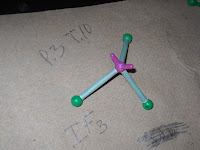Title: Polarity and Molecular shape lab
Statement of the Problem:
* We are trying construct molecular shapes by looking at their Lewis structure and see if we could determine polarity.
* We found out that there was one resonance structure and a majority of the structures were indeed polar.
Hypothesis: The molecules with hydrogen and oxygen will not be polar due to their electro negativity with other elements.
Materials:
*we had small little tubes like structures that were our bonds, and we had small little round molecules which acted as our central atom.
Procedure:
* We had determine the Lewis structures of following molecules such as SF3 or H2O and the resonance structure SO3 (-2) we then constructed the molecules by the following Lewis structure we had just done for that individual molecule. We then looked at the structure and determined the polarity simply by looking at the structure. There was one resonance structure.
Results (Data):


Octahedral, 90 degree, non-polar, resonance


Tetrahedron, 90-109.5, degrees, non-polar, and non-resonance


Tetrahedron, 109.5 degrees, non-polar, non-resonance


T-Shaped, 120 degrees, polar, and non-resonance


Octahedral, 90 degrees, non-polar, and non-resonance


Tetrahedron, 180 degrees, non-polar, and non-resonance


Tetrahedron, 90-109.5 degrees, and polar and non-resonance


Tetrahedron, 109.5 degrees, non-polar, and non-resonance
Conclusions:
* Our hypothesis was somewhat rejected because there was some molecules with hydrogen that were polar.
We had all learned about how you can determine polarity just by looking at the structure and that we could make Lewis structures and create models by using there Lewis structure
Problems that could have occurred that our calculation of the electro negativity between the molecules so that would throw off our polarity accuracy.
By: James, Marco, Justin

